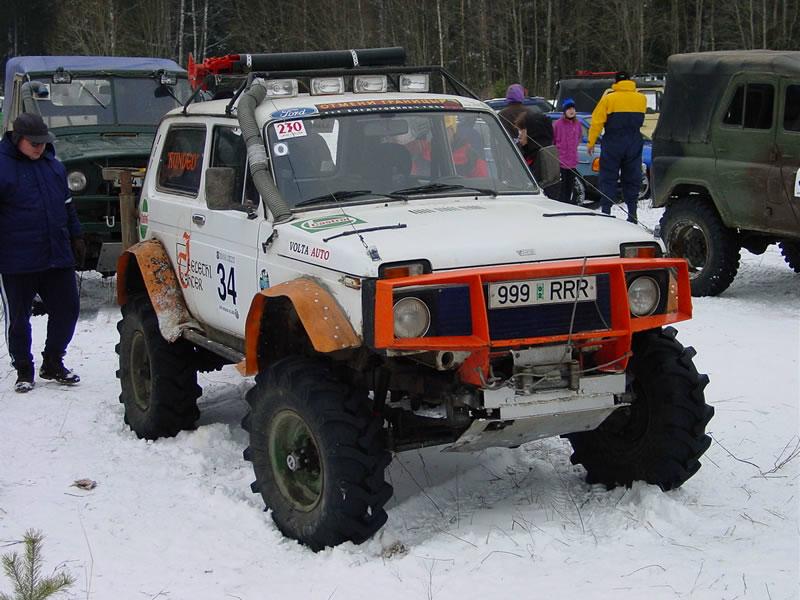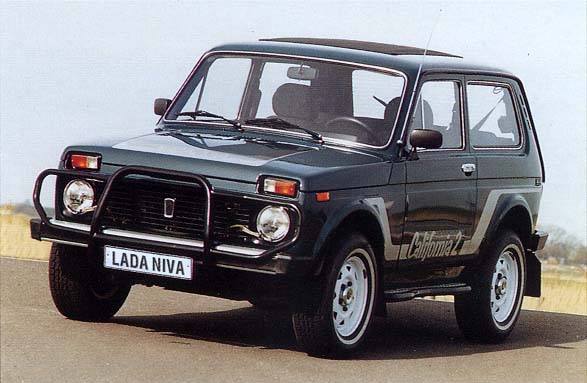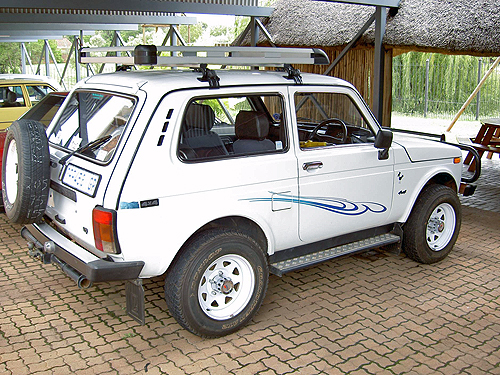Lada / Lada Niva

Specs
-
Engine1.7L
-
Power62 @ 5400 rpm
-
Transmission5-spd man w/OD
-
0-6022.0 seconds
-
Drivetrainfront+rear-wheel
-
Seating4 passengers
-
Crash testnot tested
-
MPG13.0 City / 9.0 HWY
-
Invoice Price$17,420 - $18,117
-
Warranty12 months / 16,000 miles
Specs
| Lada Niva | 1978—1991 | 5 s., manual | 78 Hp, petrol |
|---|---|---|---|
| Lada Niva | 1987—1995 | 5 s., manual | 78 Hp, petrol |
| Lada Niva 1.7i | 1995—1998 | 5 s., manual | 84 Hp, petrol |
| Lada Niva 1.7i | 2000—2010 | 5 s., manual | 82 Hp, petrol |
| Lada Niva 1.9 D | 1995—1998 | 5 s., manual | 65 Hp, diesel |
| Lada Niva 1.7 | Manual | 519HP (381 kW) @ 0 rpm | |
| Lada Niva 1.7 California | Manual | 519HP (381 kW) @ 0 rpm | |
| Lada Niva 1.7 Kult | Manual | 519HP (381 kW) @ 0 rpm | |
| Lada Niva 1.7 California Gas | Manual | 519HP (381 kW) @ 0 rpm | |
| Lada Niva 1.7 Only | Manual | 519HP (381 kW) @ 0 rpm | |
| Lada Niva 1.7 Only Gas | Manual | 519HP (381 kW) @ 0 rpm | |
| Lada Niva 1.7 Cult | Manual | 519HP (381 kW) @ 0 rpm | |
| Lada Niva 1.7 Cult Gas | Manual | 519HP (381 kW) @ 0 rpm | |
| Lada Niva | Manual | 519HP (381 kW) @ 0 rpm | |
| Lada Niva 1.8 Long | Manual | 519HP (381 kW) @ 0 rpm | |
| Lada Niva 1.7i Long | Manual | 519HP (381 kW) @ 0 rpm | |
| Lada Niva 1.9 Diesel | Manual | 519HP (381 kW) @ 0 rpm |
| Lada Granta | Manual | 519HP (381 kW) @ 0 rpm | |
|---|---|---|---|
| Lada Natacha | Manual | 519HP (381 kW) @ 0 rpm | |
| Lada S | Manual | 95HP (70 kW) @ 6000 rpm |
Worldwide Trends
GEO Interests
Videos / Lada Niva
Fifth Gear [20x02] - Lada Niva
GREECE LADA NIVA EXTREME-transformation a MERCEDES to NIVA
LADA NIVA 4x4 EXTREME OFFROAD - WATER & MUD - PART 1
Lada Niva 4x4 LT
The Lada Niva: its uses and the subsequent versions
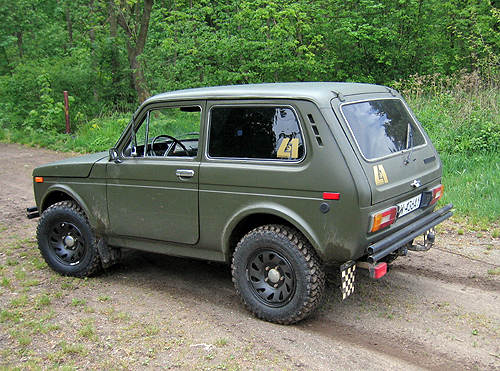 History and Overview
History and Overview
The Lada Niva is a Russian off road vehicle that is produced by AvtoVAZ. The market of the car was quite successful and was done by Lada Sport. It was one of the first unit body architecture to have hit the road. The front and coil suspension techniques are independent of each other. The crossover SUV of the present is a predecessor of this particular model. The emergency and the pickup model have been manufactured by VAZ Inter Service. The carburetted four cylindered overhead petrol engines formed the prototype for the vehicle. Multi point injection of fuel was designed by Bosch and has been highly effective ever since.
Modification
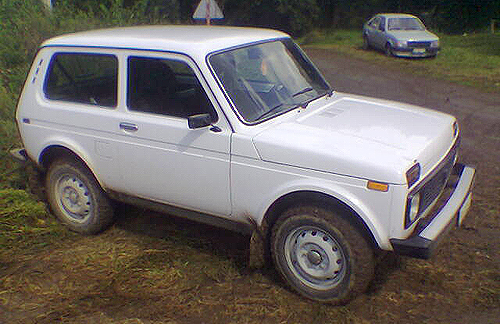 The basic model of the car has the VAZ 2121 engine that has a capacity of 1.6 litres and was able to generate about 70 hp. The prototypes were made as early as the seventies. The exporting modifications of the right hand drive restricted the opportunities of the English market. The river version is an aggressive amphibious vehicle that makes use of the same engine specifications. The restyled model had its rear ends modified with the loading height being lowered. However it had a much powerful engine that generated an even greater torque. The fuel injection technique was also upgraded. The door widths and the raised portion of the roof are the main distinguishing features. The longer versions of the model were used as outdoor beach SUVs. The Cedar model had a reoriented interior and has a bench type three seat arrangement that leans forwards slightly.
The basic model of the car has the VAZ 2121 engine that has a capacity of 1.6 litres and was able to generate about 70 hp. The prototypes were made as early as the seventies. The exporting modifications of the right hand drive restricted the opportunities of the English market. The river version is an aggressive amphibious vehicle that makes use of the same engine specifications. The restyled model had its rear ends modified with the loading height being lowered. However it had a much powerful engine that generated an even greater torque. The fuel injection technique was also upgraded. The door widths and the raised portion of the roof are the main distinguishing features. The longer versions of the model were used as outdoor beach SUVs. The Cedar model had a reoriented interior and has a bench type three seat arrangement that leans forwards slightly.
Chevrolet Niva
It is actually manufactured in collaboration with General Motors and AvtoVAZ.The designer model was previously known as VAZ2123 and the gasoline engine had a capacity of 1.7 litres. The fuel injection technology was in place. The mechanical transmission method enhanced its off road performance. The ecotec family possessed the four wheel driving system with that used a 1.8 litre gasoline engine. Minor changes were implemented in the restyling pattern as well.
Uses of the vehicle
 The Lada Niva is mostly used either as an ambulance or as a military vehicle in Russia and most parts of Europe. Previously it was also used as a lifeguard vehicle on the beaches of Netherlands. The commercial consortium of Transmanche link constructed the tunnel between English and France. The vehicle was used to accumulate raw materials for a span of over 70000 kilometres. It was disposed of to a local dealer after it completed the construction work successfully. Brazil saw cheap rates for the vehicle 80 per cent of which accounted the tax for importation values. It was much more inexpensive than its contemporary competitors like Gurgel and Envemo. The consequent growth in demand for the vehicle caused the production of Gurgel to decrease considerably. The car was first imported in the Brazillian car market in the year 1990. Plenty of Nivas are still widely used in Brazil. They are useful especially on mountainous regions and for driving through mud and underwater. It became a symbol of protest in the several movements considering its presence in such similar movements.
The Lada Niva is mostly used either as an ambulance or as a military vehicle in Russia and most parts of Europe. Previously it was also used as a lifeguard vehicle on the beaches of Netherlands. The commercial consortium of Transmanche link constructed the tunnel between English and France. The vehicle was used to accumulate raw materials for a span of over 70000 kilometres. It was disposed of to a local dealer after it completed the construction work successfully. Brazil saw cheap rates for the vehicle 80 per cent of which accounted the tax for importation values. It was much more inexpensive than its contemporary competitors like Gurgel and Envemo. The consequent growth in demand for the vehicle caused the production of Gurgel to decrease considerably. The car was first imported in the Brazillian car market in the year 1990. Plenty of Nivas are still widely used in Brazil. They are useful especially on mountainous regions and for driving through mud and underwater. It became a symbol of protest in the several movements considering its presence in such similar movements.








